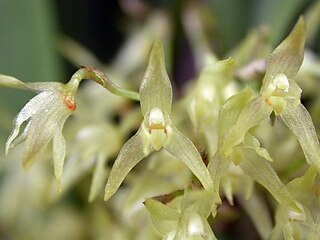
Pleurothallis is a genus of orchids commonly called bonnet orchids. The genus name is derived from the Greek word pleurothallos, meaning "riblike branches". This refers to the rib-like stems of many species. The genus is often abbreviated as "Pths" in horticultural trade.

Stelis, or leach orchids, is a large genus of orchids, with perhaps 500 species. The generic name Stelis is the Greek word for 'mistletoe', referring to the epiphytic habit of these species. These mainly epiphytic plants are widely distributed throughout much of South America, Central America, Mexico, the West Indies and Florida. Stelis is abbreviated Ste. in the horticultural trade.

Cattleya is a genus of orchids from Costa Rica south to Argentina. The genus is abbreviated C in trade journals.

Polygala is a large genus of flowering plants belonging to the family Polygalaceae. They are commonly known as milkworts or snakeroots. The genus is distributed widely throughout much of the world in temperate zones and the tropics. The genus name Polygala comes from the ancient Greek "much milk", as the plant was thought to increase milk yields in cattle.

Streptocarpus is an Afrotropical genus of flowering plants in the family Gesneriaceae. The genus is native to Afromontane biotopes from central, eastern and southern Africa, including Madagascar and the Comoro Islands. The flowers are five-petalled, salverform tubes, almost orchid-like in appearance, and hover or arch over the plant, while the pointed, elongate fruit is of a helical form similar to that of the "tusk" of a narwhal. In the wild, species can be found growing on shaded rocky hillsides or cliffs, on the ground, in rock crevices, and almost anywhere the seed can germinate and grow. For the home, there are now many hybrids of various colours and forms available.

Prosthechea is a genus of flowering plants in the orchid family (Orchidaceae). The name is derived from the Greek word prostheke (appendix), referring to the appendage on the back of the column. Appendage orchid is a common name for this genus. Prosthechea is abbreviated Psh. in the horticultural trade.

Acianthera is a genus of orchids native to the tropical parts of the Western Hemisphere, especially Brazil. It was first described in 1842 but was not widely recognized until recently. Most of the species were formerly placed under Pleurothallis subgenus Acianthera. This splitting is a result of recent DNA sequencing.

Anathallis is a genus of orchids, comprising about 97 species native to Mexico, Central America, South America and the West Indies.

Epidendrum secundum, one of the crucifix orchids, is a poorly understood reed stemmed species, which Dressler (1989) describes as "the Epidendrum secundum complex." According to Dressler, there are dozens of varieties, some of which appear to deserve species rank. Arditti and Ghani note that E. secundum has the distinction of bearing the longest seeds known in the Orchidaceae, 6.0 mm long. By comparison, the seeds of E. ibaguense are only 2.9 mm long.

Epidendrum denticulatum, one of the crucifix orchids, is a reed stemmed species which, at least in herbarium specimens, is frequently confused with E. secundum Jacq.

Acianthera hygrophila is a species of orchid plant native to Brazil.
Acianthera bidentata is a species of orchid plant native to southeast Brazil. It is synonymous with Pleurothallis bidentata and Humboltia bidentata

Acianthera binotii is a species of orchid plant native to Brazil.

Acianthera capanemae is a species of orchid plant native to Brazil.
Acianthera caparaoensis is a species of orchid endemic to Brazil. It was first formally named Pleurothallis caparoensis in 1943 and transferred to the genus Acianthera in 2001.
Acianthera pernambucensis is a species of orchid plant native to Brazil.
Acianthera sulcata is a species of orchid plant native to Brazil.

Acianthera sulphurea is a species of orchid plant native to Brazil.

Theobroma speciosum is an arboriform species of flowering plant in the mallow family native to northern South America. It is the 35th most abundant species of tree in the Amazon rainforest.
Pleurothallis ascera is a species of plant in the family Orchidaceae.
















